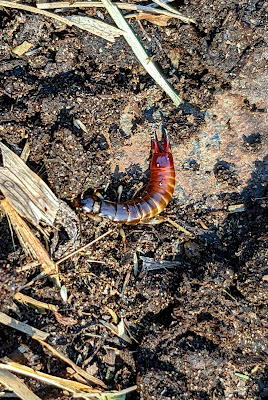Soil temp in the organic sunny hemp bed is 68F/20C. Needs to warm up a bit. #hemp #floridahemp #freshfromflorida #organic #cannabis
Healing Powers of Medical Qigong especially for seniors & those challenged with trauma from stroke and cancer. Traditional Chinese Medicine (TCM), Acupuncture, Chinese Herbs, Ancient Medical Tattooing & Yang Sheng, Nature Art & Music. Blogging about how healthy Yang Sheng lifestyles can help us thrive daily despite overwhelming chronic health issues.
Sunday, March 20, 2022
Thursday, March 10, 2022
Earwigs (Dermaptera) and Florida Organic Hemp Cultivation
 |
| Florida Organic Hemp Pest Management, Earwigs have 'pinchers' also called 'cerci' attached to the rear of their abdomen |
Tuesday, March 1, 2022
Organic Hemp Cultivation Pest Plant Alert, Lamium amplexicaule aka Henbit
Henbit, Lamium amplexicaule, is a purple flowered non-native groundcover with an aggressive growing habit renown for taking away native plants growing space.
 |
| Lamium amplexicaule, Henbit and Organic Hemp Cultivation |
Once established, henbit is difficult to eradicate.
There are two main species of Lamium in Florida, henbit and purple deadnettle, L. purpureum. Purple deadnettle differs from henbit visually with purple hued leaved near the plant top, or apex. Henbit also can be usually recognized by the way it's leaves directly clasp the stem.
Although diminutive, lacy in appearance and a rather pretty groundcover, henbit might be thought of as harmless yet the opposite is true. It is estimated by many ecological experts that almost half of all native plant species are in population decline due to loss of habitat as a result of competition from non-native species.
Lamium competes with native groundcovers for water, growing space, nutrients and importantly can be a host for hemp or other crop damaging pest insects, including a number of nematode species such as Ditylenchus spp., Heterodera spp., and Meloidogyne spp. along with a number of viruses (including Arabis mosaic virus) and fungal pathogens.
Controlling Lamium spp. in rowcrop cultivation settings can be difficult. This weedy plant is often thought of as an annual species however it may often behave as a biennial in Florida climates.
I prefer to help establish lyre-leaf sage, Salvia lyrata or turkey tangled frog fruit, Phyla nodiflora along with a host of much better suited native groundcovers that support beneficial predatory insects, beneficial pollinators and positive biological pest management.
Personally, if I see henbit growing in the hemp cultivation areas the plant quickly becomes a candidate for pulling and mechanical eradication/composting. Better safe than sorry when growing hemp.

